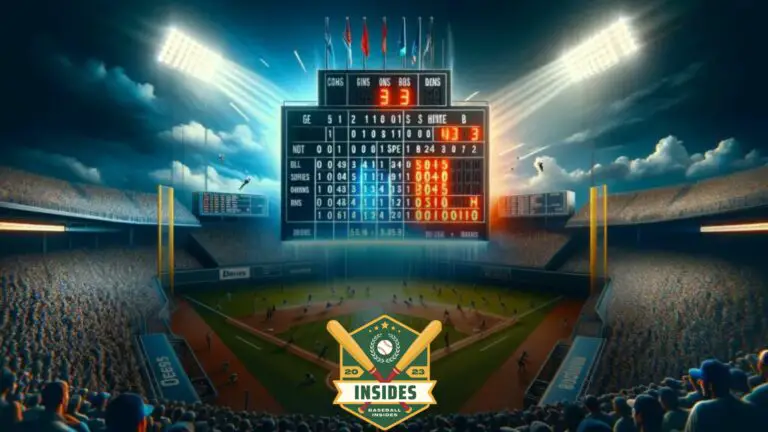
In this article:
Have you ever found yourself sitting at the edge of your seat, heart pounding, popcorn in hand, ready for a thrilling baseball match, and asked yourself a simple question – “Who bats first in baseball, the home team or the visitor?”
Well, let’s not keep you in suspense. The visiting team always bats first in a baseball game.
That’s right, and they’re the ones who kick off the match with their best swings and strategies while the home team waits patiently to respond with their game plan.
This fascinating aspect of baseball is not just tradition but a rule etched in the stone of the sport’s regulations. Stick around as we delve deeper into why this is and its impact on the game.
History of Who Bats First in Baseball
The history of who batted first in baseball is as old as the sport itself. Established in the mid-19th century, baseball rules have always favored the visiting team to start the offense.
This tradition has been maintained over the years to ensure fairness in the game.
Origination of the Rule
The rule originates from baseball’s earliest days when travel was difficult and home-field advantages were significant.
To level the playing field, the visitor was given the first opportunity to score, establishing the pattern of the visitor batting first.
In the captivating world of baseball, various terms and rules define the drama and excitement of the game. One such thrilling moment is a “Walkoff,” which occurs when the home team scores the winning run in the bottom of the final inning, allowing them to walk off the field victoriously. This electrifying event can turn the tide of a game and leave fans on the edge of their seats.
Staying Power of the Tradition
The tradition has withstood the test of time and is deeply embedded in the sport’s fabric.
Despite changes in technology, strategies, and playing conditions over the years, this rule has remained untampered and continues to dictate the game’s rhythm.
A Unique Feature
Interestingly, this is a unique feature of baseball. In many other team sports, the home team generally gets the advantage of choosing who goes first.
This distinct setup in baseball further highlights its deep-rooted traditions and love for fair play.
Home Field Advantage in Choosing Who Bats First
Let’s talk baseball, shall we? Specifically, about that all-important question, “Who gets to bat first – the home team or the visitors?”
Well, in the grand old baseball game, the visitors first step up to the plate. That’s right, the guests get dibs on the first crack at the ball.
Why Do the Visitors Bat First?
It’s all a part of the home-field advantage strategy. See, the home team gets to bat in the bottom of the innings, which means they get the final at-bat in the game.
This gives them a unique opportunity – if the game’s tied or they’re trailing by a few runs, they’ve got the last chance to swing for the fences and change the game.
How Does This Impact the Game?
The impact of this order can be significant. It’s a strategic edge that comes with being the home team.
Having the last at-bat can make or break the game, allowing the home team to adjust their strategies based on the performance of the visitors.
Isn’t it Unfair to the Visitors?
Some may argue that this seems unfair to the visiting team. However, it’s all part and parcel of the game.
Like it or not, it’s a tradition that’s been a part of baseball since its inception. And really, isn’t there something thrilling about the uncertainty and the strategy this brings into play?
Strategies for Choosing Who Bats First
Deciding who bats first in baseball is no random decision. It’s an elaborate dance of strategy and anticipation, a delicate balance of pros and cons.
Here, we’ll dive into the thought process behind this vital decision.
Understanding the Home Advantage
In baseball, the home team always bats last. This traditional rule is designed to give the home team a slight advantage as they get the final chance to score.
However, this doesn’t always translate into a winning strategy. Let’s see why.
The ‘Visitor-First’ Rule
The ‘Visitor-First’ rule is a universal norm in baseball. The visiting team always bats first. The strategy is to put pressure on the home team right from the first inning. But there’s more to it than just pressure.
Scoring Early
By batting first, the visiting team can set the game’s pace. Scoring early can give them a psychological edge, shaking the home team’s confidence and dictating the game’s dynamics.
Momentum and Morale
Momentum and morale play a significant role in baseball. When the visiting team scores first, it can boost their morale and hamper the home team’s momentum. This ‘psychological warfare’ can be a game-changer.
Final Stand
Conversely, batting last allows the home team to make a final stand. If the game is close, the home team can strategize their batting based on the situation, potentially turning it in their favor.
Factors That Determine Who Bats First
Have you ever wondered who gets to bat first in a baseball game and why? Well, it doesn’t just happen by chance.
Several factors go into determining who steps up to the plate first. Let’s dive right into it.
The Official Baseball Rules
The most significant factor is the official baseball rules. According to these rules, the visiting team always bats first.
This is set in stone and doesn’t change, no matter the circumstances. This rule applies to both professional and amateur games.
The Reason Behind the Rule
There’s a logic behind this rule, too. The home team getting the last chance to bat gives them a slight advantage.
They know exactly how many runs they need to win or tie the game when they step up to the plate in the bottom of the inning. It’s all about strategy.
Exceptions to the Rule
It might seem like there’s no room for exceptions, but there are a few. These exceptions are rare and usually only occur in non-traditional games.
For instance, in youth leagues, coaches might reverse the order to give players a different experience. But remember, these are not the norm.
The Impact of Who Bats First on the Outcome of the Game
So, who bats first in a baseball game, and why does it matter? In the wide world of sports, baseball is known for being a game of strategy, and this is one of its crucial elements.
The visitor team always bats first, while the home team takes the field. But why? Let’s delve into the specifics and see how this decision can impact the overall outcome of a game.
The Advantage of Batting Second
When the home team takes the field, they’re given a significant advantage. They can respond to the visiting team’s runs in the bottom half of the inning.
This gives the home team a chance to either extend their lead or, if they’re behind, catch up to the competition.
The Pressure of Batting First
The visiting team, batting first, faces a sort of pressure-cooker situation. They’re up against the opposing team’s pitcher without knowing how many runs they’ll need to secure a win.
This can significantly ramp up the tension, potentially affecting the visiting team’s performance.
Does Batting Order Really Matter?
The batting order is part of the intricate baseball puzzle in the grand scheme. While it does add an interesting layer of strategy, it’s only one of many factors that can influence a game’s outcome.
The combination of excellent pitching, solid defense, and timely hitting ultimately determines the winner.
Interesting Facts
- The home team has won 54% of all Major League Baseball games.
- Since 1903, the home team has won 60 of 114 World Series.
While the batting order in baseball might seem like a minor detail, it significantly impacts the game’s dynamics. Whether you’re the home team with the luxury of batting last or the visitors playing catch-up, each situation presents unique challenges and opportunities.
Another critical aspect of baseball that often goes underappreciated is the pitcher’s ERA, or “Earned Run Average.” This statistic measures the number of earned runs a pitcher allows per nine innings pitched, serving as a barometer for their effectiveness and consistency on the mound. Understanding a pitcher’s ERA can provide deep insights into their performance and the likely outcome of games they participate in.
Alternatives to Traditional Rules – The Designated Hitter Rule
Let’s play ball and dive into an interesting alternative to traditional baseball rules – the Designated Hitter Rule. This rule adds a unique twist to the gameplay, stirring up the strategic planning of both teams.
So, what’s this rule all about? Let’s find out!
What is the Designated Hitter Rule?
Founded in 1973 by the American League, the Designated Hitter Rule allows teams to choose a player solely for batting in place of the pitcher.
This switch hitter doesn’t play in the field but can give pitchers a much-needed break from batting, which isn’t typically their strongest suit.
How Does It Affect the Batting Order?
Under the Designated Hitter Rule, the batting order remains unchanged. That means the visiting team still steps up to the plate first.
The only difference is that the designated hitter bats in the rotation in place of the pitcher.
Why Was This Rule Introduced?
So why shake things up with this rule? It’s all about entertainment, my friends! The rule was introduced to increase offensive action, resulting in more exciting games.
After all, having a specialized batter in place of the pitcher increases the chances of hits and runs.
Controversy Surrounding the Designated Hitter Rule
Like any game-changer, the Designated Hitter Rule has sparked some controversy. Traditionalists argue it takes away from the game’s purity, as every player should hit and field.
On the other hand, supporters say it adds a layer of strategy and excitement, keeping fans on the edge of their seats.
So, there you have it! A quick run-down of the Designated Hitter Rule and its impact on who bats first in a game. No matter where you stand on the rule, one thing’s certain – it’s brought some serious drama to the diamond!
Baseball is also a game of precision and rules, one of which is the “Balk.” A balk is called when a pitcher makes an illegal motion on the mound that deceives a baserunner, potentially impacting the game’s flow and strategy. This rule ensures fairness and keeps the game’s integrity intact, preventing pitchers from gaining an undue advantage over baserunners.
Conclusion
In baseball’s fascinating world, the visiting team always steps up to bat first. This traditional arrangement, rooted in the principles of fairness and competitiveness, provides a unique twist to the home-field advantage concept.
A game of strategy and skill, baseball continues to enthrall fans worldwide with these distinctive rules.
Key Takeaways:
- The visiting team bats first in a baseball game, allowing them to set the pace.
- This rule is integral to the game, making baseball distinct from other sports where the home team usually gets the advantage.
- This unique arrangement adds to the competitiveness and excitement of the game, creating an engaging atmosphere for the fans.
Ultimately, the batting order doesn’t determine the game’s outcome. The skill, strategy, and team spirit lead to victory.
So whether you’re rooting for the home team or the visitors, remember to enjoy the game and cheer for your favorite players!
FAQs
1. Who Bats First in Baseball, Home or Visitor?
In baseball, the visiting team always bats first. This is a well-established rule and has been the tradition since the sport’s early days.
2. Why Does the Visiting Team Bat First?
The rule provides a slight advantage to the home team, as they get the last at-bat. This means they have the final opportunity to score in the game.
3. What is an At-bat in Baseball?
An at-bat is a player’s turn batting against a pitcher. It’s one of the most critical moments in a game, as it presents the opportunity to score runs.
4. How Many Players Are There on a Baseball Team?
A professional baseball team generally has 25 players. However, only nine players can be on the field at a time.
5. How Long is a Typical Baseball Game?
A typical baseball game lasts approximately three hours. But games can extend beyond this timeframe due to extra innings or other factors.
6. What is the “Diamond” in Baseball?
The “diamond” is a nickname for the infield, shaped like a diamond. It includes home plate and the three bases.
7. Who Invented Baseball?
While the origins of baseball are debated, it is widely credited to Abner Doubleday. Nevertheless, variations of the game have been played for centuries.
8. What is a “Strikeout” in Baseball?
A strikeout happens when a batter receives three strikes during his at-bat. After three strikes, the batter is out, and the next batter steps up to the plate.
9. What is a “Home Run” in baseball?
A Home Run occurs when a batter hits the ball far enough to circle all the bases and reach home plate in a single play, scoring a run.
10. Can a Baseball Game End in a Tie?
Unlike some sports, a baseball game cannot end in a tie. If the score is equal after nine innings, extra innings are played until a winner is determined.






